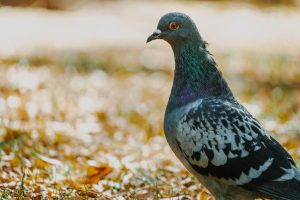Scientific Name: Columbidae
Common Names: Pigeon, Dove, Rock Pigeon, Feral Pigeon, Rock Dove
Color: Varies
Weight: 9 – 16 ounces
Length: Between 12 – 15 inches
Wingspan: 20 – 26 inches
FACT: Pigeons have color vision, a hearing range very close to that of humans and have poor senses of taste and smell. Pigeons cannot think, but are capable of conditional learning.
HABITS
There are 4 behavioural habits requiring consideration. These are feeding, nesting, roosting and loafing.
- Feeding: Pigeons prefer to feed on seeds, grain, fruit etc. However, they will feed on garbage, animal matter, livestock manure and many other foods when their preferred foods are scarce.
- Nesting: Nests are loosely constructed and usually consist of sticks, leaves and other debris. They are built on ledges of structures, cliffs or in caves. The considerable amount of cliff-like nesting sites, especially on older buildings, is one of the key factors that attract pigeons to cities. Often nesting and roosting occur in the same general area, but they can be distant.
- Roosting: Roosting sites are where pigeons rest or sleep. They usually involve some kind of perch that is often high off the ground such as exposed roof girders, protected ledges, etc. Loafing is loosely defined as when pigeons are not feeding, nesting or roosting. This may occur almost anywhere pigeons are not constantly disturbed.
- Loafing: Pigeons have very acidic droppings which can deface marble, limestone, painted surface, statues, car finishes, etc. Fresh droppings can cause objectionable odours and slippery situations on sidewalks, roads, fire escapes and other flat surfaces. Droppings, feathers and nesting materials can contaminate unprocessed grain and packaged foods. Pigeons also have diseases, ectoparasites and other pests associated with them.
CONTROL
Many options are available for bird control. There are 5 methods that do not utilize toxicants.
- Exclusion which involves structural modification (eg. Change ledge angle to 45 degrees), the installation of plastic netting, and/or the use of repellents such as plastic and metal spines, monofilament and steel lines, and gels and pastes.
- Sanitation which involves the reduction or elimination of feeding sites and temporary water sources.
- Sound Devices such as noise-making devices (usually not suitable for urban areas).
- Trapping which can be effective if the birds are destroyed and not released; otherwise, they will return home or create problems elsewhere.
- Shooting can also be effective for removing birds within some kinds of buildings.
If you find yourself with a pigeon problem, we can help! Poulin’s has seven locations throughout Western Canada. We’ll respond quickly to your call and work with you to develop a pigeon control strategy that keeps your family’s health and comfort in mind.

